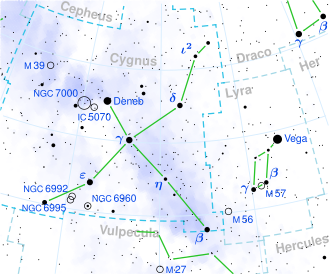| Observation data Epoch J2000 Equinox J2000 | |
|---|---|
| Constellation | Cygnus |
| Right ascension | 19h 24m 33.06773s [1] |
| Declination | +50° 14′ 29.1263″ [1] |
| Apparent magnitude (V) | 5.60 – 8.49 [2] |
| Characteristics | |
| Spectral type | M7IIIab + Be [3] |
| Variable type | Z And and SR [2] |
| Astrometry | |
| Radial velocity (Rv) | −59.74 [4] km/s |
| Proper motion (μ) | RA: −7.09 [1] mas/yr Dec.: −59.74 [1] mas/yr |
| Parallax (π) | 5.4642±0.2172 mas [5] |
| Distance | 600 ± 20 ly (183 ± 7 pc) |
| Orbit [6] | |
| Period (P) | 15.58±0.13 yr |
| Semi-major axis (a) | 8.5 AU |
| Eccentricity (e) | 0.122±0.024 |
| Inclination (i) | 84° |
| Semi-amplitude (K1) (primary) | 4.45±0.12 km/s |
| Details [6] | |
| Red giant | |
| Mass | 2 M☉ |
| Radius | 280 R☉ |
| Luminosity | 5012 L☉ |
| Temperature | 3,100 K |
| White dwarf | |
| Mass | 0.7 M☉ |
| Luminosity | 0.25 L☉ |
| Other designations | |
| HD 182917, BD+49°2999, HIP 95413, SAO 31632 | |
| Database references | |
| SIMBAD | data |
CH Cygni (CH Cyg / HIP 95413 / BD +49 2999) is a red giant, variable, symbiotic binary in the constellation Cygnus.

